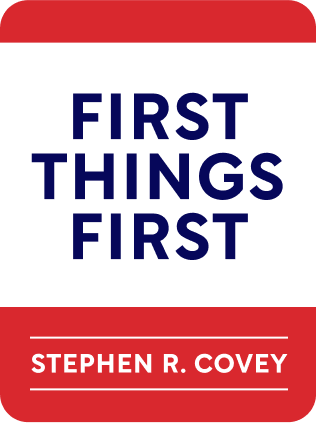

This article is an excerpt from the Shortform book guide to "First Things First" by Stephen R. Covey. Shortform has the world's best summaries and analyses of books you should be reading.
Like this article? Sign up for a free trial here .
What is Stephen R. Covey’s First Things First about? What is the key message to take away from the book?
In his book First Things First, Stephen R. Covey presents a time-management approach that focuses on priorities, or “first things.” This approach teaches you to use your time effectively rather than efficiently. Using your time effectively means focusing on what you’re spending your time on, rather than how much time you’re spending.
Here’s a brief overview of the key concepts.
The Urgency-Importance Matrix
At the heart of Stephen Covey’s book, First Things First, is the Urgency-Importance Matrix: A task can be either important, urgent, both, or neither.
The “first things” method of time management emphasizes important tasks, rather than those that are merely urgent. All our daily, weekly, and monthly activities fall into one of the following four categories, as seen below:
| Urgent | Not Urgent | |
| Important | Quadrant IUrgent and Important | Quadrant IINot Urgent, but Important |
| Not Important | Quadrant IIIUrgent, but Not Important | Quadrant IVNeither Urgent nor Important |
Quadrant I is both urgent and important. This quadrant contains emergencies and problems that require your immediate attention. This can include health emergencies, a work deadline, or a broken-down car.
Quadrant II is important, but not urgent. This is where you do prevention, maintenance, long-term planning, relationship building, and personal leadership activities like evaluating your thought patterns and assessing progress toward goals. For the highest quality of life, Quadrant II is where you should spend most of your time.
Quadrant III is urgent, but not important. The urgency of Quadrant III activities can make them appear important, but they don’t actually align with your values or contribute to the achievement of your goals. Quadrant-III activities include making phone calls, going to meetings that lack purpose, and receiving unexpected guests.
Quadrant IV is neither urgent nor important. These activities add no value to your life; even recreational activities don’t belong here because true recreation is a restorative and valuable Quadrant-II activity. Quadrant IV includes gossiping, mindlessly watching television, or passively scrolling through social media.
Quadrant-III and Quadrant-IV activities add little value to your life. You should limit time spent in these quadrants. Although Quadrant-I activities are inevitable, you should aim to spend most of your time in Quadrant II. This can be difficult, especially if you’ve spent your life reacting to the urgent business at hand rather than engaging in activities that benefit you in the long run. The first step toward spending more time in Quadrant II is to recognize when urgent tasks are not important and stop wasting your time on them. Eventually, you’ll shift to an “importance paradigm,” a mindset in which you automatically focus on spending your time doing the things that are most important to you.
Shift to an Importance Paradigm
How do you shift to an important paradigm and start spending your time on activities that align with your goals and values?
There are three principles that guide your shift to an importance paradigm.
1. You must fulfill your four human needs and capabilities: to live (the physical realm), to love (the social realm), to learn (the mental realm), to leave a legacy (the spiritual realm). Humans get a sense of fulfillment only through satisfying these four fundamental human needs. Activities that help fulfill these needs are Quadrant-II activities.
2. You must understand “true north” principles: true north principles include integrity, moderation, self-discipline, loyalty, responsibility, honesty, and patience. These are universal principles that give you direction and context for where you are now and how to reach your destination. Activities that align with true north principles are Quadrant-II activities.
3. You must understand the four human endowments: These endowments are self-awareness, conscience, independent will, and creative imagination. Activities that nurture these endowments are Quadrant-II activities.
Quadrant-II Scheduling
The heart of First Things First is Quadrant-II scheduling. This is a time management system that helps you understand your priorities and spend the majority of your time in Quadrant II, where the most personal and professional growth happens.
Step 1: Identify Your Long-Term Vision and Personal Mission
The first, foundational step of this planning process is to identify what’s most important to you, what gives your life meaning, and what do you want to achieve in your life.
One way to clarify these priorities, or “first things,” is through a personal mission statement. This is a written document in which you outline your guiding principles and long-term goals.
As you create a personal mission statement, consider the following questions:
- What are three or four “first things” that are important in your life?
- What are some of your long-term goals?
- What are the most important relationships in your life?
- What kinds of contributions do you want to make to your community, society, or the world?
Step 2: Identify Your Roles
Everyone has different roles in life: You are a spouse, son or daughter, brother or sister, father or mother, friend, professional, and individual. Often, people feel dissatisfied when they excel in one or two roles at the expense of other roles.
As you set your personal mission and manage your time to work toward that mission, it’s vital that you identify and address each of your roles so that your efforts lead to a balanced life.
Make a list of your roles. You can list them generally (e.g. family member, employee, church member) or more specifically (e.g. spouse, parent, manager, producer, deacon, parishioner). As you make your list, keep in mind that studies show that people are less effective at mentally managing more than seven categories, so try to keep the number of roles to seven or fewer.
Step 3: Set Quadrant II Goals for Each Role
Now that you’ve identified your roles, think of Quadrant II goals for each of those roles. For the time being, limit these goals to things you can do in the next seven days. Rather than addressing urgent needs, these goals should reflect your personal mission and focus on things that would make a significant, long-term difference.
For example, in your role as a parent, you may schedule quality time with your kids. In your role at work, Quadrant II goals can include allotting time for long-term strategizing or building relationships with your customers.
Once you’ve written down your goals for this week, ask yourself:
- What results do you expect if you achieve all of these goals in the next week?
- How will you feel if you only achieve some of them?
- What kind of difference would you expect to see if you did these things every week?
Step 4: Schedule Your Quadrant II Goals
Picture your weekly schedule as a jar, your Quadrant II goals as rocks, and urgent tasks as sand and gravel. If you start by filling your jar with sand and gravel, you won’t have room to fit many rocks in after. But if you start by filling it with rocks, you’ll be able to fit many more into the jar and still have room to pour in the sand and gravel — they’ll simply find space in the smaller nooks and spaces around the rocks. Similarly, if you schedule the important Quadrant II tasks into your week first, the other urgent matters will fit in around them; but if you first attend to the urgent Quadrant-I and -III activities, you’re likely to run out of room for your Quadrant-II goals.
Take the goals you listed in Step 3 and schedule them into your week — either by assigning a specific time appointment for each goal, or by writing a goal as a top priority for a given day.
Once you’ve scheduled your Quadrant II goals for this coming week, start adding in the Quadrant I tasks you need to accomplish.
As you’re doing this, be sure not to schedule every minute of each day; this method of time management requires you to maintain flexibility in your schedule for unexpected events and opportunities that will inevitably come up.
Step 5: Tackle Each Day Within the Context of Your Weekly Goals
As you move through your week, you’ll face unexpected changes in your schedule and will need to make decisions in the moment about how to proceed. The Quadrant-II organizing approach and an importance paradigm will help you navigate these decisions, but there are also a few things you can do to help you stay in line with your weekly goals and priorities.
- Start each morning by reviewing what’s on your schedule for that day.
- As you preview the day, prioritize the tasks you have scheduled. Evaluate which are Quadrant I and Quadrant II activities; this can also help you recognize if a Quadrant III activity has made it into your schedule.
- Go through your day’s activities and do “T planning,” indicating which of the day’s activities are time-sensitive and which aren’t.
Step 6: Review and Learn From Your Week
At the end of the week — before you start to make next week’s schedule — stop and consider how the week went. Did you achieve your goals? Did you face challenges? How did you handle spur-of-the-moment decisions? Did you successfully keep first things first?
Furthermore, at the end of each month or quarter, reflect on patterns to the weeks that have passed. What patterns of success or failure do you have in setting and achieving your goals? Are your expectations realistic?
Finding Win-Win Solutions
The time-management approach outlined above can also help you set goals and create management systems as a team. However, developing a vision and establishing priorities for a group has unique challenges. This is, in part, because most people approach group work and negotiation with a “win-lose” mindset — if you win, someone else must lose. But to reach your goals in an interdependent world, you need to change how you think about winning. Winning doesn’t mean someone else loses; winning means accomplishing your goals, and you can accomplish more if you cooperate rather than compete.
How to Create a Win-Win Solution
There are three steps to the win-win process:
1. Approach the problem with a “win-win” attitude: This first step is actually a way of thinking rather than an action. To create wins for everybody, you need to first acknowledge that individual success at the expense of the group isn’t true success.
2. Listen first, then speak: The second step involves listening and seeking to understand the other person’s point of view. Don’t speak until you understand all the sides of the issue, and until others in the group are satisfied that you understand.
3. Synergize: The last step is to create a list of alternatives that are better than the solutions that any individual could come up with herself.
Win-Win Stewardship Agreements
Stewardship agreements help establish priorities and keep group members working effectively toward the same goals. Using the “win-win” process is important when creating stewardship agreements.
When creating the agreement, you and your group have to contend with five elements and the questions that come with them:
- Desired Results: What outcome(s) do we want to achieve?
- Guidelines: What values, legalities, and limits do we need to be aware of?
- Resources: What money, people, and technology do we have to work with?
- Accountability: How will we know when we’ve reached our goal? What criteria will we use to measure our success?
- Consequences: What will happen if we achieve our goals? What will happen if we don’t achieve our goals?
Dealing with these elements thoughtfully and collaboratively takes time, but in the long run, this process will save you time because it will limit the problems that come from miscommunication and unclear expectations and objectives.
Ultimately, learning to listen to your conscience and act on its guidance is the single best thing you can do to manage your time well, live a higher-quality life, and find lasting peace. One of the most powerful questions you can ask your conscience is, “What can I do to make a difference?” The answer to this one question may dramatically alter how and in what you invest your time.

———End of Preview———
Like what you just read? Read the rest of the world's best book summary and analysis of Stephen R. Covey's "First Things First" at Shortform .
Here's what you'll find in our full First Things First summary :
- How to work effectively, not just efficiently
- Why you need to think more about what you're spending time on than how much time you're spending
- The 6 steps to effectively schedule and prioritize important activities






